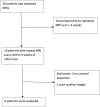A Feasibility Study of Quantifying Longitudinal Brain Changes in Herpes Simplex Virus (HSV) Encephalitis Using Magnetic Resonance Imaging (MRI) and Stereology
- PMID: 28125598
- PMCID: PMC5268482
- DOI: 10.1371/journal.pone.0170215
A Feasibility Study of Quantifying Longitudinal Brain Changes in Herpes Simplex Virus (HSV) Encephalitis Using Magnetic Resonance Imaging (MRI) and Stereology
Abstract
Objectives: To assess whether it is feasible to quantify acute change in temporal lobe volume and total oedema volumes in herpes simplex virus (HSV) encephalitis as a preliminary to a trial of corticosteroid therapy.
Methods: The study analysed serially acquired magnetic resonance images (MRI), of patients with acute HSV encephalitis who had neuroimaging repeated within four weeks of the first scan. We performed volumetric measurements of the left and right temporal lobes and of cerebral oedema visible on T2 weighted Fluid Attenuated Inversion Recovery (FLAIR) images using stereology in conjunction with point counting.
Results: Temporal lobe volumes increased on average by 1.6% (standard deviation (SD 11%) in five patients who had not received corticosteroid therapy and decreased in two patients who had received corticosteroids by 8.5%. FLAIR hyperintensity volumes increased by 9% in patients not receiving treatment with corticosteroids and decreased by 29% in the two patients that had received corticosteroids.
Conclusions: This study has shown it is feasible to quantify acute change in temporal lobe and total oedema volumes in HSV encephalitis and suggests a potential resolution of swelling in response to corticosteroid therapy. These techniques could be used as part of a randomized control trial to investigate the efficacy of corticosteroids for treating HSV encephalitis in conjunction with assessing clinical outcomes and could be of potential value in helping to predict the clinical outcomes of patients with HSV encephalitis.
Conflict of interest statement
Dr Simon S Keller is funded by a UK Medical Research Council grant, grant number MR/K023152/1 and Prof Tom Solomon is funded by the National Institute for Health Research by a Programme Grant for Applied Research with grant number RP-PG-108-10048. All other authors have no competing interests.
Figures





Similar articles
-
Acyclovir resistance in herpes simplex virus type I encephalitis: a case report.J Neurovirol. 2017 Apr;23(2):335-337. doi: 10.1007/s13365-016-0489-5. Epub 2016 Oct 27. J Neurovirol. 2017. PMID: 27787806 Free PMC article.
-
[A 61-year-old female who suffered from herpes simplex encephalitis with expanded cerebral lesions on MRI and prolonged clinical course--the diagnostic usefulness of PCR using biopsied brain tissue specimens].Brain Nerve. 2008 Dec;60(12):1475-80. Brain Nerve. 2008. PMID: 19110760 Japanese.
-
Untreated herpes simplex virus encephalitis without a fatal outcome.J Neurovirol. 2021 Jun;27(3):493-497. doi: 10.1007/s13365-021-00968-y. Epub 2021 Mar 31. J Neurovirol. 2021. PMID: 33788139
-
Update on herpes simplex encephalitis.Rev Neurol Dis. 2004 Fall;1(4):169-78. Rev Neurol Dis. 2004. PMID: 16400278 Review.
-
[Acyclovir resistant acute herpes simplex encephalitis associated with acute retinal necrosis: A case report and review of the literature].Rinsho Shinkeigaku. 2017 May 27;57(5):230-233. doi: 10.5692/clinicalneurol.cn-000959. Epub 2017 Apr 28. Rinsho Shinkeigaku. 2017. PMID: 28450685 Review. Japanese.
Cited by
-
Quantitative Imaging Metrics for the Assessment of Pulmonary Pathophysiology: An Official American Thoracic Society and Fleischner Society Joint Workshop Report.Ann Am Thorac Soc. 2023 Feb;20(2):161-195. doi: 10.1513/AnnalsATS.202211-915ST. Ann Am Thorac Soc. 2023. PMID: 36723475 Free PMC article.
-
Increased volume of cerebral oedema is associated with risk of acute seizure activity and adverse neurological outcomes in encephalitis - regional and volumetric analysis in a multi-centre cohort.BMC Neurol. 2022 Nov 7;22(1):412. doi: 10.1186/s12883-022-02926-5. BMC Neurol. 2022. PMID: 36344954 Free PMC article.
-
Neuropsychological and psychiatric outcomes in encephalitis: A multi-centre case-control study.PLoS One. 2020 Mar 25;15(3):e0230436. doi: 10.1371/journal.pone.0230436. eCollection 2020. PLoS One. 2020. PMID: 32210460 Free PMC article.
-
Protocol for DexEnceph: a randomised controlled trial of dexamethasone therapy in adults with herpes simplex virus encephalitis.BMJ Open. 2021 Jul 22;11(7):e041808. doi: 10.1136/bmjopen-2020-041808. BMJ Open. 2021. PMID: 34301646 Free PMC article.
References
Publication types
MeSH terms
Substances
Grants and funding
LinkOut - more resources
Full Text Sources
Other Literature Sources
Medical

